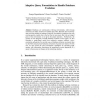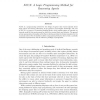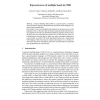26 search results - page 2 / 6 » A Linear-Logic Semantics for Constraint Handling Rules |
EACL
1993
ACL Anthology
13 years 7 months ago
1993
ACL Anthology
Semantic theories of natural language associate meanings with utterances by providing meanings for lexical items and rules for determining the meaning of larger units given the me...
CAISE
2006
Springer
13 years 9 months ago
2006
Springer
Databases are continuously evolving environments, where design constructs are added, removed or updated quite often. Research has extensively dealt with the problem of database evo...
CORR
2004
Springer
13 years 5 months ago
2004
Springer
FLUX is a programming method for the design of agents that reason logically about their actions and sensor information in the presence of incomplete knowledge. The core of FLUX is...
VLDB
1993
ACM
13 years 9 months ago
1993
ACM
Mb describe the design and implementation of a constraint management facility for our active object-oriented database system called Jasmine/A. The facility includes integrity cons...
SOFSEM
2009
Springer
14 years 2 months ago
2009
Springer
Abstract. Constraint Handling Rules (CHR) is a general purpose, committedchoice declarative language which, differently from other similar languages, uses multi-headed (guarded) ru...



